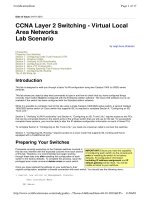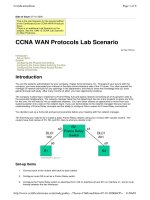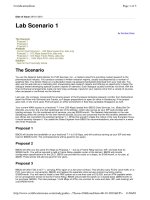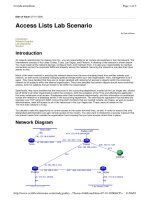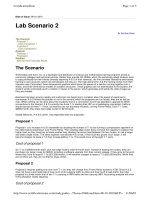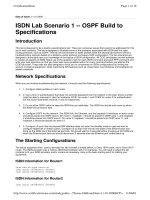CCNA WAN Protocols Lab Scenario
Bạn đang xem bản rút gọn của tài liệu. Xem và tải ngay bản đầy đủ của tài liệu tại đây (33.44 KB, 6 trang )
CertificationZone Page 1 of 6
11/06/01
Date of Issue: 07-01-2000
CCNA WAN Protocols Lab Scenario
by Dale Holmes
Introduction
Set-up Items
Solution
Configuring the Physical Connectivity
Configuring the Frame Relay Switching Function
Configuring the Frame Relay Access Routers
Testing Connectivity
Introduction
You are the systems administrator for your company, Happy Acres Growers, Inc. Throughout your tenure with the
company, you have expressed your interest in the data communications side of the IT house. You often queried the
manager of network services for any openings in the department, and tried to show the knowledge that you have
gained through self-study. After many months of effort, you hear opportunity knocking.
The company is planning to implement a Frame Relay hub-and-spoke network connecting all of its growers' sites to
the corporate headquarters. The network manager feels that his department has too many projects to spare any time
for this one. He will need to hire an additional engineer. You have been offered an opportunity to move from your
systems position into a slot on the network team, if you can demonstrate to the network manager that you have an
understanding of Frame Relay concepts and the ability to configure Cisco routers for Frame Relay connections.
You decide to set up a home lab and get some practice before your meeting with the network manager.
The first thing you need to do is create a basic Frame Relay network using your 3 Cisco 2501 access routers. The
routers have host names of R1, R2, and R3. Here is what you decide to do:
Set-up Items
1. Connect each of the routers with back-to-back cables.
2. Configure router R2 to act as a Frame Relay switch.
3. Configure the Frame Relay switch to advertise DLCI 102 on interface s0 and 201 on interface s1, and to route
frames between the two interfaces.
This is the Lab Scenario for the second edition
of the CertificationZone CCNA WAN Protocols
Issue.
There is an additional Lab Scenario on the
subject. See the 1999-12 CCNA Lab Scenario
on Wan Protocols.
CertificationZone Page 2 of 6
11/06/01
4. Configure the remaining two routers for Frame Relay connections. Allow them to use Inverse ARP to detect
the DLCIs.
5. Configure an IP address of 10.10.10.1/24 on R1 and 10.10.10.2/24 on R3.
6. Verify connectivity across the Frame Relay link using the ping command.
7. Examine Frame Relay LMI activity on router R1.
8. Examine the state of the PVCs on each R1 and on R2.
Solution
Configuring the Physical Connectivity
a. Connect the DTE end of a Cisco back-to-back cable to the
s0 interface of R1.
b. Connect the other end of this cable to the s0 interface of
R2.
c. Connect the DTE end of another back-to-back cable to the
s1 interface of R2.
d. Connect the other end of the cable to the s0 interface of R3.
Configuring the Frame Relay Switching Function
(Set-up item 2)
Configure R2 to act as a Frame Relay switch. Follow these steps:
a. login to the router, and enter Privileged Exec mode.
R2>enable
password:*******
R2#
b. Enter Global Configuration mode.
R2#conf t
c. Enable Frame Relay switching.
R2(config)#frame-relay switching
d. Configure each interface for Frame Relay encapsulation.
R2(config)#int s0
R2(config-if)#encapsulation frame-relay
R2(config-if)#int s1
R2(config-if)#encapsulation frame-relay
e. Configure the router to provide a clockrate of 56 Kbps.
R2(config-if)#clockrate 56000
f. Configure the LMI type on each serial interface.
You can tell if a DTE or a DCE plug is inserted
into a given serial interface with the show
controller serial x where x is the interface
number. Another way to tell if a DCE plug is
connected is that only DCE interfaces will
accept a clockrate command. clockrate and
bandwidth are independent commands, can
have different values, and appear both on DTE
and DCE interfaces.
CertificationZone Page 3 of 6
11/06/01
R2(config-if)#frame-relay lmi-type ansi
R2(config-if)#int s0
R2(config-if)#frame-relay lmi-type ansi
g. Configure each serial interface to act as DCE.
R2(config-if)#frame-relay intf-type dce
R2(config-if)#int s1
R2(config-if)#frame-relay intf-type dce
(Set-up item 3)
h. Configure each serial interface to route incoming frames to the
other serial interface.
R2(config-if)#frame-relay route 201 interface Serial0 102
R2(config-if)#int s0
R2(config-if)#frame-relay route 102 interface Serial1 201
Configuring the Frame Relay Access Routers
(Set-up items 4 and 5)
Configure R1 for Frame Relay operation. Follow the steps below:
a. Enter Interface Configuration mode for R1's interface s0.
Configure Frame Relay encapsulation.
R1(config-if)#encapsulation frame-relay
b. Configure the LMI type.
R1(config-if)#frame-relay lmi-type ansi
c. Assign IP addresses to the s0 interfaces on routers R1.
R1(config-if)#ip address 10.10.10.1 255.255.255.0
d. Enter Interface Configuration mode for R3's interface s0. Configure Frame Relay encapsulation.
R3(config-if)#encapsulation frame-relay
e. Configure the LMI type.
R3(config-if)#frame-relay lmi-type ansi
f. Assign IP addresses to the s0 interfaces on router R3.
R3(config-if)#ip address 10.10.10.2 255.255.255.0
Testing Connectivity
(Set-up item 6)
Save your configs on each router, then test for connectivity across the Frame Relay link using the ping command.
Extra Credit Challenge
How can you repeat the command with the
least amount of typing?
Answer: Use the up arrow to repeat
commands.
Tip
You've done quite a bit of configuration. An
intermediate "save" here would be
conservative practice.
CertificationZone Page 4 of 6
11/06/01
a. Save configs using the copy running-configuration startup-
configuration command on each router:
R1#copy run start
R2#copy run start
R3#copy run start
b. Test for connectivity across the Frame Relay link using the ping
command on routers R1 and R3.
R1#ping 10.10.10.2
Type escape sequence to abort.
Sending 5, 100-byte ICMP Echos to 10.10.10.2,
timeout is 2 seconds:
!!!!!
Success rate is 100 percent (5/5),
round-trip min/avg/max = 64/67/68 ms
R3#ping 10.10.10.1
Type escape sequence to abort.
Sending 5, 100-byte ICMP Echos to 10.10.10.1,
timeout is 2 seconds:
!!!!!
Success rate is 100 percent (5/5),
round-trip min/avg/max = 64/67/68 ms
(Set-up item 7)
Examine the LMI activity on R1
a. Examine the output of the following command:
R1#debug frame-relay lmi
Frame Relay LMI debugging is on
Displaying all Frame Relay LMI data
R1#
00:19:57: Serial0(out): StEnq, myseq 88, yourseen 87, DTE up
00:19:57: datagramstart = 0xE30BD8, datagramsize = 14
00:19:57: FR encap = 0x00010308
00:19:57: 00 75 95 01 01 01 03 02 58 57
00:19:57:
00:19:57: Serial0(in): Status, myseq 88
00:19:57: RT IE 1, length 1, type 1
00:19:57: KA IE 3, length 2, yourseq 88, myseq 88
00:20:07: Serial0(out): StEnq, myseq 89, yourseen 88, DTE up
00:20:07: datagramstart = 0xE30BD8, datagramsize = 14
00:20:07: FR encap = 0x00010308
00:20:07: 00 75 95 01 01 01 03 02 59 58
00:20:07:
b. Turn off debugging with the undebug all command:
R1#u al
All possible debugging has been turned off
c. Use the show frame-relay lmi command on R1.
R1#show frame-relay lmi
LMI Statistics for interface Serial0
(Frame Relay DTE) LMI TYPE = ANSI
Invalid Unnumbered info 0 Invalid Prot Disc 0
Note:
write memory is an earlier name for the same
command as copy run start, but Cisco has
said it will eventually drop support for write
mem. You might find a very old IOS version
that only accepts write mem.
CertificationZone Page 5 of 6
11/06/01
Invalid dummy Call Ref 0 Invalid Msg Type 0
Invalid Status Message 0 Invalid Lock Shift 0
Invalid Information ID 0 Invalid Report IE Len 0
Invalid Report Request 0 Invalid Keep IE Len 0
Num Status Enq. Sent 106 Num Status msgs Rcvd 106
Num Update Status Rcvd 0 Num Status Timeouts 1
(Set-up item 8)
Examine the state of the Frame Relay PVCs on router R1 and R2.
R1#show frame-relay pvc
PVC Statistics for interface Serial0 (Frame Relay DTE)
Active Inactive Deleted Static
Local 1 0 0 0
Switched 0 0 0 0
Unused 0 0 0 0
DLCI = 102, DLCI USAGE = LOCAL,
PVC STATUS = ACTIVE, INTERFACE = Serial0
input pkts 11 output pkts 12 in bytes 1074
out bytes 1108 dropped pkts 0 in FECN pkts 0
in BECN pkts 0 out FECN pkts 0 out BECN pkts 0
in DE pkts 0 out DE pkts 0
out bcast pkts 2 out bcast bytes 68
pvc create time 00:15:09,
last time pvc status changed 00:08:09
R2#show frame-relay pvc
PVC Statistics for interface Serial0 (Frame Relay DCE)
Active Inactive Deleted Static
Local 0 0 0 0
Switched 1 0 0 0
Unused 0 0 0 0
DLCI = 102, DLCI USAGE = SWITCHED,
PVC STATUS = ACTIVE, INTERFACE = Serial0
input pkts 13 output pkts 12 in bytes 1142
out bytes 1108 dropped pkts 1 in FECN pkts 0
in BECN pkts 0 out FECN pkts 0 out BECN pkts 0
in DE pkts 0 out DE pkts 0
out bcast pkts 0 out bcast bytes 0 Num Pkts Switched 13
pvc create time 01:23:06,
last time pvc status changed 00:13:08
PVC Statistics for interface Serial1 (Frame Relay DCE)
Active Inactive Deleted Static
Local 0 0 0 0
Switched 1 0 0 0
Unused 0 0 0 0
DLCI = 201, DLCI USAGE = SWITCHED,
PVC STATUS = ACTIVE, INTERFACE = Serial1
input pkts 13 output pkts 13 in bytes 1138
out bytes 1142 dropped pkts 0 in FECN pkts 0
in BECN pkts 0 out FECN pkts 0 out BECN pkts 0
in DE pkts 0 out DE pkts 0
out bcast pkts 0 out bcast bytes 0 Num Pkts Switched 12
pvc create time 01:23:39,
last time pvc status changed 00:13:28
[NA-WANP-LS2-F03]
[2000-06-28-01]

